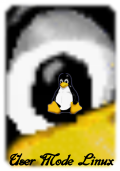| How the docs are done |
The source for all UML documentation is XML, with a set of tags invented, ad-hoc, one-the-fly, by me. This is processed into the UML web site and the HOWTO with XSL, using Transformiix, which is the Mozilla XSL processor.The documentation source is in CVS under /doc/web. A variety of files are located here:
In addition, there are a large number of files which are copied verbatim into the site. These include
- XML files - the documentation source itself
- Makefile - the Makefile knows how to build and sync the web site, and how to build the HOWTO, as both HTML and text.
- sgml.xsl and uml.xsl - the XSL scripts, sgml.xsl builds the SGML source for the HOWTO, which is converted into HTML and text with the sgml-tools utilities, and uml.xsl builds the web site.
- md.pl - a little perl script which combines page.xml, which is the web boilerpate, into a single XML document which each of the other XML files. This allows Transformiix to combine them into an HTML file.
- sgml.pl - another little perl script which combines a subset of the XML files into a single XML document along with some other bits of information. This combined document is then converted into the SGML source file for the HOWTO.
- A number of pictures
- UML slides and papers from various conferences, in various forms
- A few text files
- All of the UML patches which have been sent to Alan, since I reference these from my diary
| What needs doing |
Some things were already mentioned:The aesthetics of this site may not be the best. Improvements are welcome. Also, there are a lack of diagrams and pictures which might help clarify things. Contributions would also be welcome.
- Checking the site for spelling and grammar errors
- Checking it for untrue statements, particularly HOWTOs that don't work as advertised
- Looking for HOWTOs, that while technically are true, do not describe the best, quickest, or simplest way to get the job done
Improvements to the layout and organization would be good. It might also be nice to have some kind of automatically generated news section on the main page which lists the latest UML happenings or the latest site updates.
This site mostly contains HOWTO-type material. If you would like to see other sorts of things here, speak up, or write it up and send it in.
The utilities that ship with UML need man pages. I'd like XML source that can be converted into man page source, HTML, and SGML. It's OK if all these outputs look something like man pages. We can add new sections to the site and the HOWTO for them.
The XML tagset being used here is probably not the world's most sane XML schema. Improvements and simplifications would be welcome. Also, the abstract tags are not used everywhere they should be.
The site needs an advanced networking page. This should cover things like
- Multiple UMLs networking via the host
- Setting up a virtual network with one or more nodes acting as gateways to the host
- Bridging - I have a walkthrough which needs to be incorporated
- Maybe setting up IPv6
- Setting up a ppp link over a UML console or serial line in order to run what amounts to a dial-up connection to the host. Also, setting up the serial lines of two UMLs so that one can dial up to the other.
